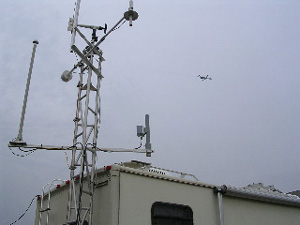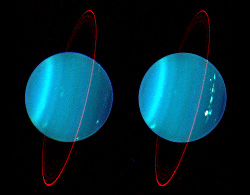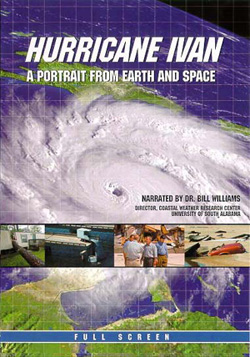Monthly News Articles – March 2005
New project attracts attention
In January, SSEC joined with NASA in an effort to provide pilots with better weather information. Recently, several researchers from SSEC traveled to Memphis as a part of this program.
 |
|
SSEC’s AERIbago acts as a mobile weather laboratory and helps to validate new weather instruments.
|
With a modified Winnebago, nicknamed the AERIbago, SSEC will help test the accuracy of measurements taken from recently designed weather instruments built to fly aboard commuter aircraft. The data gathered from the new instrument will go to weather forecasters, pilots and the airports to develop better forecasts of severe weather, potential icing and visibility.
From February 23 through March 11, researchers with SSEC’s Cooperative Institute for Meteorological Satellite Studies (CIMSS) used the AERIbago to test the quality of measurements taken from the Tropospheric Airborne Meteorological Data Reporting (TAMDAR) instrument. The TAMDAR AERIbago Validation Experiment (TAVE) is underway at the Memphis Tennessee Air National Guard facility. Wayne Feltz (CIMSS) is the scientist in charge of CIMSS’s TAVE operations.
 |
| John Short prepares to launch a weather balloon. The AERIbago is parked behind him. |
Data gathered by CIMSS through this experiment made it into the National Weather Service’s discussion group, including a link to CIMSS’s Memphis data page. “It’s great to know that people are using this data!” said researcher Sarah Bedka (CIMSS) in a TAVE daily report.
The Memphis branch of the National Weather Service also featured a description of the TAMDAR Great Lakes Fleet Experiment on their Web site. It includes information about the experiment and why Memphis was an important research stop. A picture of John Short(SSEC) holding a weather balloon accompanies the article.
– view more pictures from Memphis
Extreme temperatures : Matthew Lazzara of SSEC’s Antarctic Meteorological Research Center is featured in an article on Antarctica’s weather in Meteogiornale, an Italian Web-based science news magazine. Using data from SSEC’s Automatic Weather Station (AWS) program, writer and cold-weather specialist Stefano Di Battista lists temperatures that have fallen below –80 C. Lazzara is pictured in the field with an AWS.
Investigating a plane crash: SSEC provided satellite data sets to theCloud Physics Research division of the Meteorological Service of Canadafor use in their investigations of a 2002 plane crash. Using data from GOESand the AVHRR Pathfinder Atmospheres Extended product, they hope to determine the cause of the November 2002 crash in Flagstaff, AZ. Currently, it is believed that the crash resulted from icing.
 |
|---|
|
A pair of Lawrence Sromovsky’s images
|
Uranus by way of Wisconsin:Lawrence Sromovsky’s (SSEC) images of Uranus taken with the Keck II telescope appeared in The Planetary Report accompanying an article about the telescope and its exciting images of Uranus. Sromovsky is quoted explaining how the telescope can “reveal many more cloud features than the Voyager spacecraft found after traveling all the way to Uranus.”
Adding aerosol data: The AVHRR Pathfinder Atmospheres Extended (PATMOS-x) project seeks to reprocess AVHRR data using many algorithms developed through NESDIS. Andrew Heidinger (CIMSS) recently received a set of aerosol optical data tables that he then incorporated into the project’s data stream. This addition makes the reprocessed data more useful for climate studies.
 |
|
The cover of the Hurricane Ivan DVD
|
Dreams of warmer weather: SSEC personnel assisted meteorologists from the 3-D Research Corporation who provide weather support in the Marshall Islands. The meteorologists requested access to specific GOES-10 data sets gathered over the Hawaiian island of Kauai. This data will support a military project scheduled for March 2005.
Ivan on DVD: The Coastal Weather Research Center recently produced a DVD chronicling Hurricane Ivan, which hit the United States’ Gulf Coast during the 2004 hurricane season. The DVD, Hurricane Ivan: A Portrait From Earth and Space, uses McIDAS imagery to re-create this destructive storm.
Presentations and Publications
A report for the future: SSEC played a significant role in many aspects of the National Research Council’s 2004 publication titled “Utilization of Operational Environmental Satellite Data: Ensuring Readiness for 2010 and Beyond.” SSEC’s Allen Huang acted as the chair of the Committee on Environmental Satellite Data Utilization for this report with Rosalyn Pertzborn (SSEC) as the assistant to the chair. Paul Menzel(NOAA/NESDIS at SSEC) received acknowledgment in the forward for providing briefings and background information. The report also uses SSEC imagery and data. The clouds in the cover image were created using SSEC data and an image of winds for Hurricane Bonnie created by Bormin Huang(CIMSS) appears in the first chapter.
Mixed-phase paper published: The Journal of the Atmospheric Sciences published a paper about mixed-phase clouds co-authored by Jeff Key (NOAA at SSEC) in collaboration with various scientists from around the country. The paper provided insight into some observations made during the Surface Heat Budget of the Arctic (SHEBA) experiment.
Sharing knowledge: The Earth Observer for November/December 2004 published the minutes of the Aqua Science Working Group Meeting held October 26-27, 2004. At the meeting, Allen Huang (CIMSS) presented some of CIMSS’s cloud research conducted using satellite data. He spoke inJun Li’s (CIMSS) stead, as Li was unable to attend. Huang discussed many of CIMSS’s efforts to combine MODIS imaging and AIRS sounding data. He specifically addressed examples of cloud-clearing and cloud-top property activities. Li’s other presentation, submitted electronically, highlighted updates of certain satellite data products such as the MODIS water vapor product.
Looking ahead: In collaboration with the NESDIS Advanced Satellite Products Branch, CIMSS plans to host the second NOAA/NESDIS Cooperative Research Program Science Symposium here at UW-Madison. This year’s symposium will be held July 13-14, following the CIMSS silver anniversary celebration. The topic will be satellite calibration and product validation.The first symposium, held last June, featured discussions on measuring and modeling aerosols.
Scientific storytelling: While talking with Patty Loew of the UW’s Life Science Communications’ Department two years ago, Sanjay Limayelearned of the similarities between Native American folk stories and current scientific theory. Together, they decided to find a culturally relevant way to teach Native American students about space science. Loew and Limaye’s concept can now come to fruition by way of the Ira and Ineva Reilly Baldwin Wisconsin Idea Endowment, a grant given to seven projects around the state that advance the Wisconsin Idea. Their project will encourage students at Native American schools throughout the upper Midwest to explore the connections between space science and folk tradition.
Out at sea: CIMSS researcher Kevin Baggett participated in an outreach collaboration between the Royal Caribbean International ship Explorer of the Seas and the University of Miami’s Rosensteil School of Marine and Atmospheric Science. From February 6 to February 13, Kevin gave tours of the atmospheric lab and presented lectures to the general public. His main talk was entitled, “Satellite Observations of the Ocean and Atmosphere,” and included highlights of the MODIS, AIRS, and GOES instruments. It also touted future instruments such as GIFTS and those on GOES-R. Explorer of the Seas carries an SSEC instrument, the Marine Atmospheric Emitted Radiance Interferometer, to make precise measurements of the interface of air and sea. For more information on this University of Miami program, visit their Web site at http://www.rsmas.miami.edu/rccl/
Explaining science to the public: Shaima Nasiri will educate the public about weather balloons at this year’s Science Expeditions, an outreach event coordinated by Science Alliance at UW-Madison. At her exploration station in the Engineering Centers Building, Nasiri will explain how a weather balloon operates and why the data gathered aboard the balloons is important to weather forecasters. If the weather allows it, Nasiri will launch a balloon as a demonstration. In addition to Nasiri’s booth, two other research centers based in the AO&SS building will have exhibits at the event. The Environmental Remote Sensing Center plans to have a WisconsinView booth and the Center for Climate Research will educate the public about snowflakes. IceCube also has plans for a booth. Find them all on the Science Expeditions 2005 schedule.
